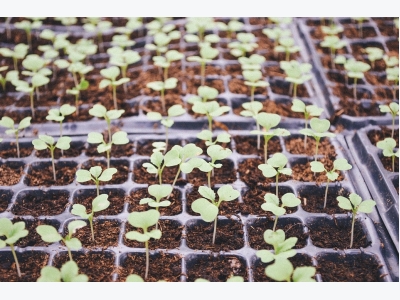Using Seedling Mats for Seed Germination Temperature

Starting your own plants from seeds is a great way to save money in the garden, but it's not always easy getting the right balance.
Seeds need ample amounts of light, water, oxygen and temperature to germinate and grow. Too little or too much of any of these things and germination can fail altogether or seedlings can die right in their youth, never maturing into flowering or fruit-bearing plants.
Many beginner gardeners place their seed flats in a windowsill thinking it to be a prime growing spot, but it's usually quite the opposite. Why? Window sills can be among the coldest places in the house, especially at night, and then the hottest during the day. Most seeds need consistently warm temperatures to germinate and produce a strong root system. Ideal temperatures for germination depend on the plant, but generally speaking, seeds need a consistent temperature of between 65 and 75 degrees.
How do you achieve this idyllic consistent temperature? One almost surefire method is to use a seedling mat, an electric heating pad that sits under the seedling trays, usually regulated by a thermostat. Using the mat will speed germination, produce healthier seedlings and prevent damping off.
Seedling mats are generally sized to hold one, two or four standard-sized nursery flats. The mats may come with a thermostat or you can purchase one separately for use with multiple mats. Either way, it's a good idea to have some sort of temperature control to keep plants from overheating.
How to Use Seedling Mats
- Check your seed packages to determine the ideal temperature and light exposure for seed germination.
- Place the heat mat on a flat dry surface in an area that matches the light requirements for your seeds. This could be a natural or artificial light source. Note: Some seeds require total darkness for germination.
- Plug in the heat mat and set the thermostat to the desired temperature range.
- Place the seed flat on top of the mat, evenly distributing the heat source across the bottom of the flat.
- Check the flats every day to make sure the heat is held at a steady temperature and the soil has consistent adequate moisture. Heating the soil generally causes it to dry out more quickly.
- As soon as the seeds germinate, remove the plants immediately from the heating mat, otherwise they'll grow too fast and become leggy and weak. The plants can be moved to another area to continue growing at a slower pace and can eventually be transferred into the ground or to another larger pot.
Using Seedling Mats in a Greenhouse
Greenhouses are ideal for germinating seeds in late winter and early spring because they supply a steady source of light, warmth, humidity and oxygen. They aren't always warm enough, however, and can be quite costly to heat. Thermostat controlled seedling mats are an excellent alternative to expensive heating systems and target the heat directly where it's needed and for the exact amount of time -- nothing could be more efficient.
Alternatives to Seed Mats to Warm Soil
Many people find seed mats to be too expensive, especially when there are many cheaper, do-it-yourself options for heating soil for germination. These include placing seed trays on top of the refrigerator, television or other warm spot. If you're more mechanically inclined, you could use shelving and wire up a 40 watt incandescent bulb positioned under the shelf along with a thermostat to keep the temperature at an even 75 to 80 degrees.
If you don't want to wire, you could use a portable light, desk light or clamp mounted fixture to heat the soil. You could also enclose the area with plastic to recreate a greenhouse effect and allow front flaps for access. Just remember with all of these methods, you want to make sure the area is dry and you leave plenty of space around the bulb in case of overheating.
Related news
 How to Get Rid of Invasive Bamboo
How to Get Rid of Invasive Bamboo Bamboo is a beautiful plant from Asia. There, nature provides a balance of predators and disease that keep bamboo in check.
 How to Grow Crossvine
How to Grow Crossvine Crossvine is a graceful vining plant loaded with lustrous green leaves and bright, trumpet-shaped flowers during late spring and throughout summer.
 How to Grow Boxwood Shrubs
How to Grow Boxwood Shrubs With their small, evergreen leaves, boxwoods are most widely used as tightly clipped hedges, but they can be allowed to take a more natural form or clipped into